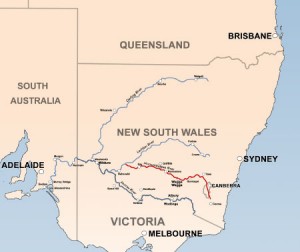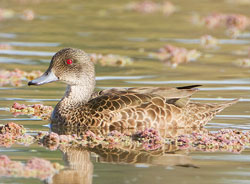
Map of the The Murray-Darling river system with the Murrumbidgee river in red. Source: Wikipedia
Australia is a dry continent and as a result Australian ecologies can generally be characterised as “boom and bust” and are significantly driven by intermittent and unpredictable wet “booms” and dry “busts”. The populations and movements of many animals are considerably influenced by these wet and dry periods. Birds tend to be “nomadic” and go where the water is. Native Australian ducks are no exception.
Before the arrival of Europeans and their agriculture, ducks only had to compete with other native birds and animals, as well as Aboriginal hunters.

Grey Teal (Anas gracilis).
Source: Wikimedia
However, the introduction of water intensive agricultural activity by Europeans changed all this and in particular rice cultivation has been implicated in altering the Murrumbidgee river system in Australia, and as a result the habitat for ducks. The guest on this episode of the podcast is Emily O’Gorman, an Associate Research Fellow at the Australian Centre for Cultural Environmental Research of the University of Wollongong. She is an expert on Australian flooding and river history and examines on this podcast the ways in which ducks as well as people negotiated the changing water landscapes of the Murrumbidgee River caused by the creation of rice paddies.
Information on Emily O’Gorman’s book
Flood Country: An Environmental History of the Murray-Darling Basin – Info from the Publisher.
Music credits
“Forecast” by cdk
Available from ccMixter
“Where You Are Now” by Zapac
Available from ccMixter


Recent Comments